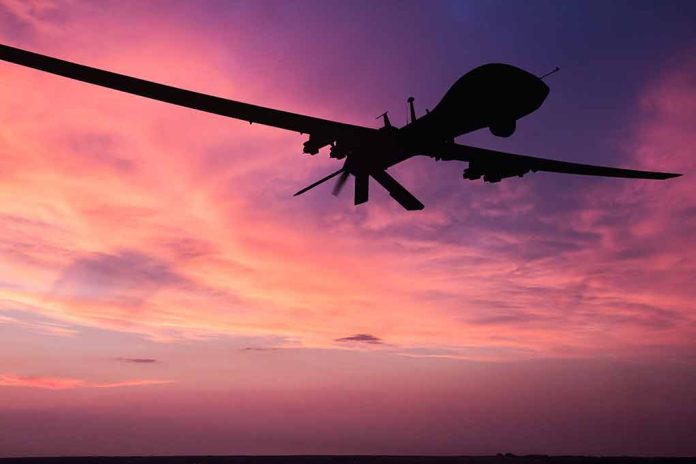
Ukraine lands devastating blow to Putin’s Black Sea operations, annihilating a sophisticated Russian radar system and military depots in a precision drone strike that signals escalating warfare capabilities in a conflict with no end in sight.
Key Takeaways
- Ukraine’s Security Service (SBU) destroyed a Russian Neva radar system and multiple supply depots on gas production platforms in the Black Sea using coordinated surface and aerial drone strikes
- The sophisticated Neva-B radar system was capable of tracking up to 200 targets with a 45 km detection range, representing a significant loss for Russian maritime surveillance capabilities
- The operation demonstrates Ukraine’s increasing strategic advantage in Black Sea operations through advanced drone warfare tactics
- The attack came in response to what Ukraine described as the largest Russian drone assault of the war to date
- Ukraine has established a pattern of successfully targeting Russian naval assets, having previously attacked 11 Russian warships and the Crimean Bridge
Ukraine’s Precision Strike Cripples Russian Black Sea Operations
Ukrainian forces have executed a bold strike against Russian military infrastructure in the Black Sea, targeting gas production platforms repurposed for military operations. The Security Service of Ukraine (SBU) announced that their coordinated drone assault successfully destroyed a sophisticated Neva radar system along with multiple military supply depots on the platforms. This tactical operation employed both surface and aerial drones working in concert, showcasing Ukraine’s growing capabilities in complex maritime operations. The attack specifically targeted Russian installations on Ukrainian offshore drilling rigs known as the Boyko towers, which Russia had seized and converted into military surveillance outposts.
The operation was carried out by the 13th Main Directorate of the Military Counterintelligence Department of the SBU, employing innovative drone coordination tactics. Evidence provided by Ukrainian forces includes video footage showing drones approaching the Russian installations and subsequent explosions. According to military analysts, the operation likely utilized FPV (First Person View) drones with objective control from a surface vehicle, demonstrating Ukraine’s tactical flexibility in naval warfare. This pattern of successful maritime drone operations has given Ukraine a significant strategic advantage in Black Sea operations.
⚡️Security Service of Ukraine destroyed a Russian radar and warehouses on gas production platforms in the Black Sea with surface and air drones.
Defenders from the 13th Main Directorate of the Military Counterintelligence Department of the SSU conducted a combined special… pic.twitter.com/5s9psNjrQp
— Anton Gerashchenko (@Gerashchenko_en) May 19, 2025
High-Value Russian Assets Destroyed
The primary target of the Ukrainian strike was a Neva-B radar system, a sophisticated piece of equipment capable of tracking up to 200 targets simultaneously. Operating in the Ka-band with a 2.5-meter-long antenna, this radar system provided Russians with crucial surveillance capabilities across a 45-kilometer range. Its destruction significantly degrades Russian ability to monitor Ukrainian naval and aerial movements in the Black Sea region. The radar system was mounted on a tower of the gas production platform, making it a high-priority target for Ukrainian forces seeking to diminish Russian surveillance capabilities.
“With the help of surface and air drones, it destroyed enemy radars and warehouses,” stated the Security Service of Ukraine, highlighting the effectiveness of their coordinated attack strategy.
Following the initial radar strike, a second drone targeted military supply depots at the facility, further undermining Russian operational capacity in the region. The platforms were being used not only for surveillance but also as logistical hubs for Russian forces. The SBU claims this operation is part of a broader strategy that has successfully targeted 11 Russian warships and struck the strategically crucial Crimean Bridge, though these claims haven’t been independently verified in all instances. These operations collectively demonstrate Ukraine’s commitment to challenging Russian control of maritime territory Ukraine considers sovereign.
Escalating Drone Warfare
The attack came shortly after what Ukrainian officials described as the largest Russian drone assault since the conflict began more than three years ago. This appears to represent an intensifying cycle of drone warfare between the two nations, with escalating technological sophistication on both sides. Ukraine has previously demonstrated advanced drone capabilities, including successfully shooting down a Russian Su-30 fighter jet using a specially modified Magura-7 naval drone equipped with AIM-9M missiles, proving their ability to adapt commercial technology for military applications.
“We once again reminded the enemy that no Russian trash has a place in the Black Sea,” declared the Security Service of Ukraine, emphasizing their determination to contest Russian presence in waters Ukraine considers its own territory.
The Black Sea remains a critical theater of operations in the ongoing conflict, particularly since Russia undermined a US-backed maritime truce in March. Control of these waters impacts not only military operations but also commercial shipping, energy security, and regional stability. Ukraine’s growing proficiency with drone warfare represents a strategic approach to challenging a numerically superior opponent by leveraging technological innovation and asymmetric tactics. While Ukrainian claims of operational success require independent verification, video evidence suggests significant damage was inflicted on Russian installations.









